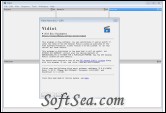|
Vidiot 
|
Vidiot is a video editor targeted for plain home video editing. It uses the following third party software: wxWidgets, Boost, FFmpeg, Portaudio, and Soundtouch.
Basic editing:
1. Create a new project: File - New, Change name: File - Save As
2. Add your video files: Right click on project name in project view - Add - Folder from disk
3. Create a 'sequence' from the given input files: Right click on folder in project view - Make Sequence
4. Edit the sequence: Trim, Drag & drop, Copy & Paste, Edit
5. Select output file and codecs: Sequence Render settings, Render the sequence: Sequence - Render
Clip details:
When a clip is selected in the timeline, the details view gives options to edit the clip. When a edit operation is in progress (currently: only trimming) the details view gives information on that operation. In the clip details view, the following can be edited:
1. The length of the clip can be changed to one of the predefined lengths.
2. The opacity of the clip can be changed. For sequences with multiple tracks this means that clips in 'lower' tracks become visible when reducing a clip's opacity.
3. The scaling options can be changed. Use any of the predefined scaling methods, or choose 'custom' to set the scaling factor yourselves.
4. The alignment options can be changed. Use any of the predefined alignment methods, or choose 'custom' to set the video position yourselves.
Trim details:
During trimming, the details view shows both the original and the resulting length (as a result of trimming) of the selected clip.
Preview:
The preview window shows a preview of the timeline video. When not playing back video it shows the frame at the timeline's cursor position.
Projects:
Select the 'File' menu and then select 'New' to create a new project. The new project becomes visible in the Project View with a generated name. The frame rate used in the project is the default frame rate as specified in the Options dialog.
Rendering:
Via the menu Sequence - Render settings, the settings of the to be generated video can be changed. In this dialog you can select the target file name (and container format), the video codec and the audio codec.
Timeline:
The timeline is where the actual video editing is done.
General Options:
Load last project on startup: When checked, after startup the most recently edited project is automatically opened.
Video Options:
1. Framerate for new projects: Output framerate (fps) to be used for projects. It is not possible to change this after creation of the project.
2. Default video width: Output video width of new projects. It is not possible to change this after creation of the project.
3. Default video height: Output video height of new projects. It is not possible to change this after creation of the project.
4. Default video scaling: When new clips are added to a sequence, a scaling method may have to be applied. This setting indicates what scaling method is applied by default. Note that this can be changed per clip, afterwards.
5. Default video alignment: When new clips are added to a sequence, a alignment method may have to be applied. This setting indicates what alignment method is applied by default. Note that this can be changed per clip, afterwards.
Images Options:
Default length of images: If still images are added to a sequence, they are given an intial length. This setting indicates this length.
Audio Options:
1. Default audio sample rate: Output audio sample rate of new projects. It is not possible to change this after creation of the project.
2. Default number of audio channels: Output number of audio channels of new projects. It is not possible to change this after creation of the project.
Timeline Options:
1. Begin marker expansion/contraction (s): When starting a new region, the begin position can be slightly offset to the position at which shift was pressed. use this value to adjust that offset. Can be negative to move to the left, or positive to move to the right.
2. End marker expansion/contraction (s): When ending a new region, the end position can be slightly offset to the position at which shift was released. use this value to adjust that offset. Can be negative to move to the left, or positive to move to the right.
3. Text to remove from clip names: If all clips have similar names (for instance, if a lot of clips start with video_ ...) , it is possible to remove that text from the clips in the timeline by entering it here.
The license of this software is Free, you can free download and free use this video editing software.
